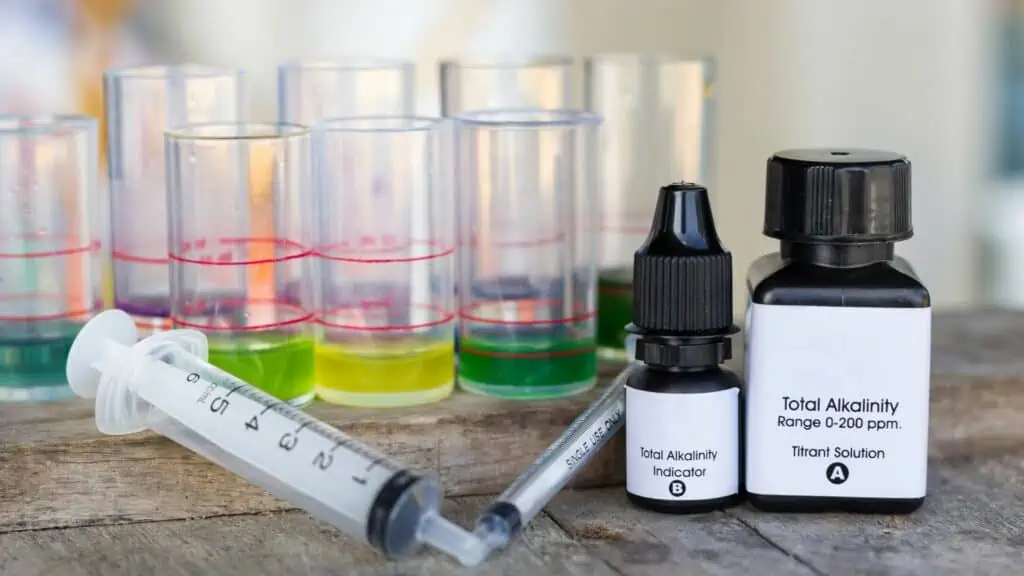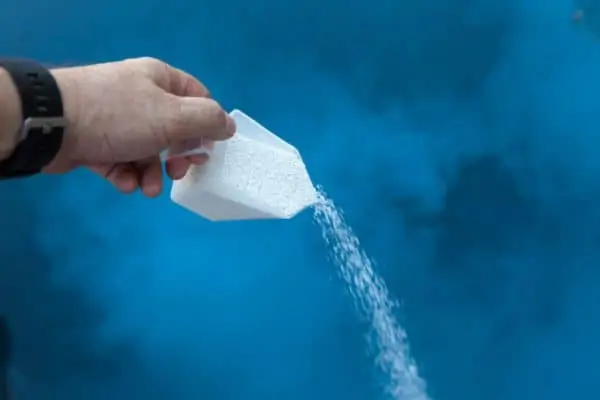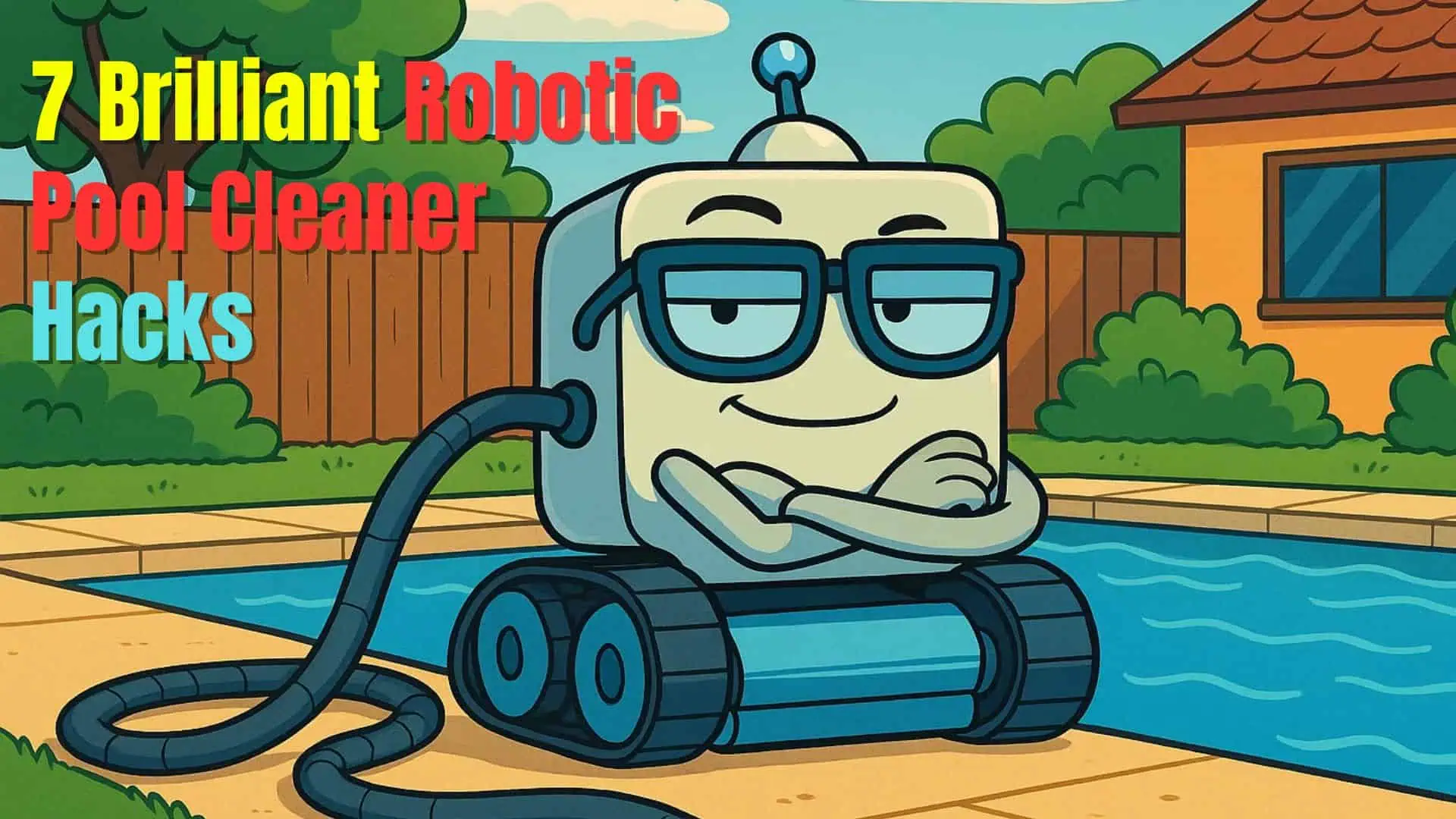High pool alkalinity is a very common problem in swimming pools. Most inground pools should have an alkalinity level of 80-120 ppm and a total alkalinity level between 200 and 400 ppm. An ideal range is lower than 100 ppm for effective sanitization.
Therefore knowing how to lower alkalinity in pool water is important for a pool owner. We will go into how to treat high alkalinity in pool below.

How to reduce alkalinity in pool water
One of the best ways to lower the total alkalinity in pool water is by adding muriatic acid, which does not affect the chlorine level in the pool.
The acid balances the pH levels while simultaneously removing calcium carbonate buildup on pool surfaces. This process should only take an hour to complete and can reduce alkalinity by up to 50%.
While adding a substance such as muriatic acid to lower the pool’s alkalinity involves minimal risk, here we will also discuss some other ways how to lower the total alkalinity in a swimming pool, and they are:
- Lowering alkalinity with dry acid, which can be safely added to the pool water and does not require any additional equipment.
- Adding sodium bicarbonates to dissolve calcium and magnesium carbonate scale and to maintain pH balance.
Whatever solution you go for will result in quick, safe relief from health concerns associated with high alkalinity levels in both an inground and above ground pool. They can be added directly into the pool or into every return jet, vacuum breaker line, and bypass connection.
How to lower alkalinity with muriatic acid?
Muriatic acid is an effective cleaning solution that can be used to clean up swimming pools, spas, and other bodies of water. It’s typically used for removing algae and bacteria by lowering the pH levels of the water and increasing oxygen levels in the water.
Lowering or increasing the pH levels in pools can significantly impact your chlorine levels. It’s very important to read the instructions on the container before adding it to your pool.
Typically, the amount of muriatic acid to lower the pH you will need will depend on the actual pH level of your pool, so for the exact measurements, you can check out this helpful pool pH level calculator.
Knowing the correct pH water level of your swimming pool will give you an ideal range of exactly how much muriatic acid you would need to balance total alkalinity in your pool water.
What happens if you add too much muriatic acid?
If you put too much muriatic acid in a pool, it will cause the pH of the water to drop, and the water will become much more acidic. This can damage the pool equipment and cause algae to grow more quickly.
Pool water with an alkalinity level above 8.5 dKH can damage pool infrastructure, including your expensive pool pump, and cause algae to grow more quickly. That’s why you need to make sure to test the swimming pool total alkalinity level of your pool water regularly and maintain the perfect pH balance in your pool.
If the pH level is 9.3 or above, then it can cause severe further damage and scale on the metal parts of your swimming pool as well as gunite walls and concrete slabs.
Lowering Alkalinity Using Dry Acid
You can also use a dry acid such as hydrochloric acid or sulfuric acid to lower total alkalinity. Follow the manufacturer’s instructions to work out how much dry acid to add, and be sure to wear gloves and eye protection when handling the acid.
You need to be very careful when handling the acid containers. Some manufacturers may tell you to add this directly into your pool.
If that’s the case, add it at night after closing, and be sure to add a pH increaser such as sodium bicarbonate, baking soda or soda ash (sodium carbonate) to neutralize the chemical. Otherwise, swimmers might feel some stinging or even unwanted serious burning.
Test the pool water with test strips or some other method before you allow anyone to swim.
Further reading – What does baking soda do?

Reducing Alkalinity with Sodium Bisulfate
Sodium bisulfate is another great alternative to muriatic acid that will lower your pool’s pH and reduce alkalinity. It can be added directly to the water, but it can cause irritation, so it is recommended to add this chemical through a feeder such as with a floater or automatic dozer.
Sodium bisulfate is used to reduce total alkalinity in swimming pools that have an existing problem with algae growth that cannot be controlled by chlorine measures alone. If you have this same problem, it is best to consult a pool professional or other qualified person before you go with this method.
As always, ensure that you wear protective clothing and eyewear when handling any chemicals and follow the manufacturer’s instructions for dosage and time.
What is a pool’s pH balance?
The pH balance of your pool can make or break the sanitary environment of its surroundings. A high pool alkalinity level in your pool will raise pH and interrupt the ideal level, which is 7.2-7.8.
Any kind of balance-off can lead to eye irritation, dry skin, and chlorine consumption. Luckily, lowering the total alkalinity in your pool is an easy process with this list of tips.
- Check the pH level and the total pool alkalinity before you open it for the new season. In order to avoid any inconveniences, it is important to know where you stand before beginning any pool maintenance.
- Choose the right dissolver for your pool. They will help lower alkalinity levels by breaking down the calcium and magnesium carbonates that form the high alkalinity.
- Use a pH adjuster to bring the pH level down to 7.8 or lower. A pH adjuster is a small pump that attaches to your pool’s filter and releases a controlled amount
If the pH of the pool is not balanced, it can lower the effectiveness of your chlorine and reduce the swimming enjoyment. High alkalinity can also cause itching as a negative side effect. However, this does not mean that you should lower the chlorine level in your pool.
What causes high alkalinity in pools?
The most common causes of high alkalinity are failing to maintain the proper pH balance, improperly handling the chlorine, storing the chemicals in an area that is exposed to sunlight, or not using a pool cover.
There are many easy ways to lower the total pool alkalinity that will remove any scum that is floating on top. If you have a filter, add more chlorine or bromine tablets as needed.
Additionally, calcium hardness levels that are too high can also lead to high alkalinity levels. That’s why it is crucial to work on lowering it as soon as possible in order to protect the swimmer’s health and keep the chlorine level effective.
You can also use an alkaline neutralizer which lowers the pH of the water by adding sodium hydroxide. Shut off your pump for 10 minutes and stir the water with your pole.
Additionally, calcium hardness levels that are too high can also lead to high alkalinity levels. That’s why it is important to work on lowering it as soon as possible in order to protect the swimmer’s health and keep the chlorine level effective. You can also use muriatic acid as an alkaline neutralizer which lowers the water’s pH level.
Can you swim in a pool with high alkalinity?
High alkalinity levels can cause problems for swimmers. The high levels can make it difficult to breathe and can also cause skin irritation. If you are swimming in a highly alkaline pool, it is important to wear a swim mask and swim slowly and with caution.
All homeowners and pool owners should take the time to learn about total alkalinity and pH balance in pools. This way, you can protect the well-being of your swimming pool and the well-being of those swimming in it.

Conclusion
In conclusion, learning how to lower alkalinity in a pool can greatly improve your swimming experience. An imbalanced pH and total alkalinity levels in your swimming pool can significantly affect the health of your swimming pool and the environment around it, resulting in cloudy pool water.
A test kit will reveal the amount of acidity or alkalinity present in the water and the amount of calcium and magnesium present. An ideal pH for a pool is anywhere from 7.2-7.8 pH level.
The higher the pH, the more dangerous the chlorine levels are to your water. An over-chlorinated pool can create unhealthy bacteria in the pool and on the body. The best way to lower your alkalinity levels is by adding muriatic acid or dry acid, or sodium bisulfate.
Remember always to wear protective clothing and eyewear when handling any chemicals and to follow the manufacturer’s instructions for dosage and timing.
By understanding the often overlooked but important pool chemistry, you can keep your swimming pool safe and enjoyable for all who wish to soak up the sun.
If you have the opposite problem ie. low pH in your pool then read my post How to raise pH in pool for more details of how to do this.






Leave a Reply